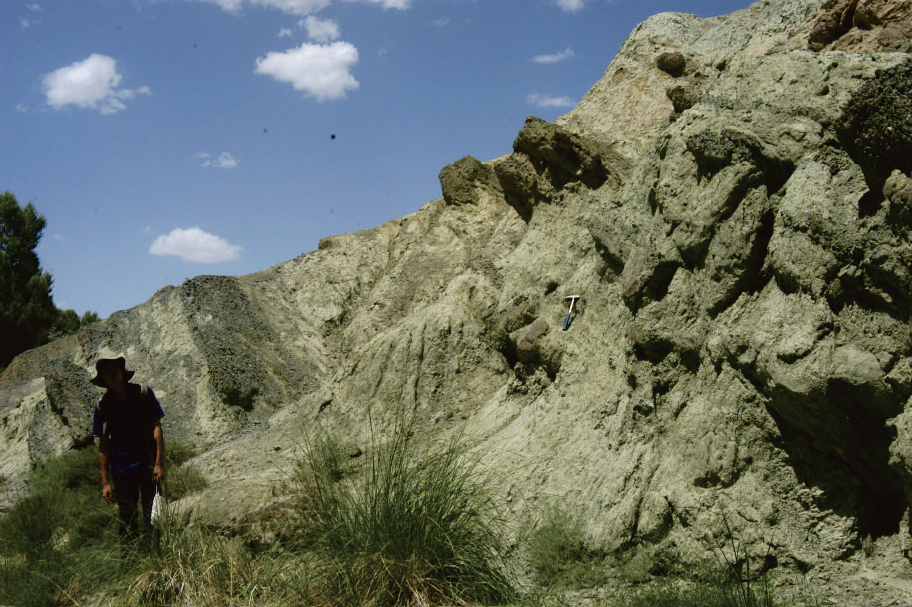Chijinbao Fm
Type Locality and Naming
Jiuquan Basin. Wang Shangwen erected the “Chijinpu series” in 1951. The section for the designation is in Chijinpu 20 km north of the Yumen city of Gansu, and the reference section is in the Chijin township of Beiyao of Chijin, the Yumen City (97°34′; 40°45′30″). In 1982 Ma Qihong called it the Chijinbao Formation and was placed as lowest formation of the Xinminpu Gr.
Synonym: The Chijinpu series is placed under the Huihuipu series and was attributed to Late Jurassic. In the report on the lithostratigraphic sorting of Gansu compiled in 1994, the original meaning of the Chijinpu series was resumed, which was however attributed to Early Cretaceous.
Lithology and Thickness
The Chijinbao Formation consists primarily of purple red and gray green conglomerate, sandstone and sandy mudstone and gray black shale with coal streaks and marl. It is 885 m thick.
[Figures: Chijinbao Formation in Xinminbao section of northern Qilian Mountain, Gansu]
Relationships and Distribution
Lower contact
Its basal part, represented by spot-weathered gray green or purple red sandstone and conglomerate, lies unconformably on the granite body of the pre-Sinian Dunhuang Gr in type section. Elsewhere, shown as unconformable on Xiangtang Fm by Dangpeng Xi, Xiaoqiao Wan, et al. (2019; Integrated Stratigraphy and TimeScale of China). But " The Chijinqiao Fm (see that formation) is of the same lithology as this Chijinbao Fm." suggests it is perhaps coeval or underlying?
Upper contact
Its top of gray black shale contacts conformably with yellow sandstone of the overlying Xiagou Fm.
Regional extent
The present formation mainly occurs in Chijinqiao, Beiyao of Chijin, and Xiagou of west Jiuquan basin as well as in Ejin Qi of the Inner Mongolia. Within the Gansu Province it is quite persistent in lithology from west to east, ranging from 373 to 885 m in thickness. In the Beishan area of Inner Mongolia, the lower part of the formation is built up by loess colored thick-bedded conglomerate; the middle part gray and dark gray mudstone and shale interbedded with loess colored fine sandstone, intercalated with gypsum and coal streaks; and the upper part gray black siltstone interbedded with medium-coarse-grained arkose, intercalated with marl, gypsum and siderite, of 547 m thick. The Chijinqiao Fm is of the same lithology as this Chijinbao Fm.
GeoJSON
Fossils
The formation yields abundant fossils, like bivalves Sphaerium jeholense, S.selenginerse; gastropods Probaicalia vitimensis; ostracods Cypridea latiovata, C.chinensis, etc.; insects Ephemeropsis trisetalis, Coptoclava longipoda; estherias Eosestheria middendorfii and Pisces Sinamia sp. in the Chijinqiao area; Pisces Sunolepis yumenensis; floras Brachyphyllum sp., Pagiophyllum sp. in Kuantanshan of the Yumen City; Pisces Ikechaoamia orientalis; Ostracods Cypridea unicostata; floras Onychiopsis elongata in Diwuopu; bivalves Sphaerium anderssone, S.subplauum; estherias Neodiestheria sp.in Ejin Qi of the Inner Mongolia. This formation also contains bivalves Ferganoconcha subcentralis, F.yanchanensis; estherias Eosestheria oblonga, Diestheria yixianensis, Liaoningestheria yixianensis; ostracods Cypridea unicostata, C. (Cypridea) sinensis, C. (Morinia) ocolota, Darwinula contracta, Ziziphocypris simakovi; Pisces Jiuquanchtyys liui, Coccolepis yumensis and Lycoptera sp.; Charophytes dominated by Aclistochara and also including A.hungarica, A.cali, Charites xiagouensis, Tolypella stipitata, Sphaerirochara paragranulifers; and sporopollen represented by the Cicatricosisporites-Pinuspollenites-Classopollis assemblage.
Age
Depositional setting
It is suggestive of piedmont-lacustrine facies.
Additional Information

